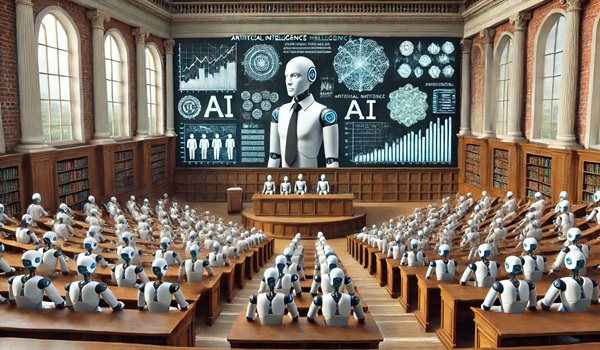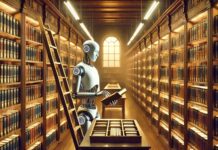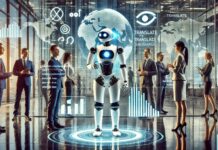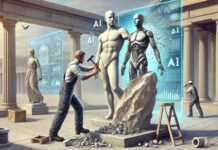Each week we find a new topic for our readers to learn about in our AI Education column.
This week on AI Education we’re going to discuss deep learning—which is a type of AI model related to machine learning. Here’s IBM’s definition:
“Deep learning is a subset of machine learning that uses multilayered neural networks, called deep neural networks, to simulate the complex decision-making power of the human brain. Some form of deep learning powers most of the artificial intelligence (AI) applications in our lives today.”
If you’re wondering how we stumbled into this topic, we went on a search-engine hunt through recently published AI-related papers in scientific journals and found no shortage of articles focused on different applications of deep learning algorithms, particularly within the health care and biotechnology industries.
Machine learning typically involves neural networks using one or two computational layers of nodes—the filling in the artificial intelligence sandwich—to function, but machine learning is not the networks themselves, rather, the process of training AI systems with data to do something that we want them to do—to find something within the data and generate an output based on that finding. Deep learning involves neural networks with three or more computational layers, today often hundreds or thousands of layers of nodes, to make decisions.
The extra layers make a huge difference. Deep learning models are capable of unsupervised learning, extracting information and insights from large volumes of unstructured data in ways that exceed the capabilities of more simplified artificial intelligence. Deep learning models are also capable of self-evaluation and self-refinement—allowing them to become more accurate and efficient, to an extent, over time.
How Deep Learning Works
We’ve discussed neural networks in previous AI Education articles, but, briefly, they are computers built to mimic the functionality of the human central nervous system, with systems delegated to taking and understanding in data (input), classifying and analyzing data with weights and biases, performing computations, and then generating output data. Using our sandwich metaphor, the input and output layers that we interact with are like the bread, and the computational layers in between are like the meat, cheese and vegetables—but they’re cheese and vegetables that users can’t see.
Deep learning uses deep neural networks, with layer upon layer of nodes, each building upon the previous layer and each serving to refine and optimize the previous layer’s output. In other words, this is technology ideally built to find needles in haystacks—and many of deep learning’s current applications revolve around some iteration of a difficult search through a large, disorganized volume of disorganized information.
While most machine learning models have to be trained on structured data—requiring human intervention to help them do what their creators and users want them to do—deep learning automates more of this process. As a result, deep learning models need less human intervention to develop, and they can ingest more data and more different kinds of data, since it does not have to be structured.
Categories of Deep Learning Models
It may be helpful to mention a few (but by no means not all) categories of deep learning models. The following models may be used solo, but are more commonly deployed as compound AI with other deep learning models.
Convolutional Neural Networks
Sometimes abbreviated as CNNs, convolutional neural networks are built to find detailed patterns in information. They’re commonly used to power image classification and speech recognition systems.
Recurrent Neural Networks
Recurrent Neural Networks, or RNNs, are also used in speech recognition systems, as well as other natural language applications. RNNs are good at using time-series data to make predictions, so they’re also employed in investing and business planning.
Generative Adversarial Networks
Also called GANs, generative adversarial networks are designed to be self-training—and are often used to train other models in turn. IBM’s example is a GAN with an image generator that creates an “artificial” AI image, and a discriminator that compares that image against a dataset of real images, prompting the generator to correct and refine its work until the discriminator cannot distinguish real images from the artificial ones.
Transformers
Ah yes, we’ve discussed transformers before but because of their importance they merit a mention here. Transformers are the technology underpinning today’s generative AI. They are capable of understanding a block of complex data, like text in natural language, in its entirety simultaneously, inferring the relationships between words and the information being conferred. As generative AI users have experienced, they are also capable of rapidly generating large volumes of content.
What Deep Learning Can Do
Computer Vision
Through its ability to detect detailed information from images in real time, deep learning is helping to power autonomous vehicles, industrial robots and other automation. The technology is also helping health care practitioners to sort through diagnostic images like x-rays and CT scans to search for diseases.
Pattern Recognition
Beyond computer vision applications, deep learning models can also look through other diagnostic data to help inform health care decisions both on the level of the individual patient and in scale to local, regional, national and global health systems. Within the financial services sector, deep learning is helping to power fraud detection. In a broader law enforcement application, deep learning can identify patterns of criminal activity.
Generative AI
Deep learning is the key technology behind the current generation of AI content creation—We know generative AI can create convincing text articles for the web, but that’s just the tip of the iceberg. AI has already helped the two surviving Beatles “clean up” old recordings of their bandmates’ voices and is being used extensively in post-production work in film and television. Deep learning models are the knowledge workforce of the future.
Handle Complexity
Machine learning-trained AI is great at linear tasks or functions that can be described with simple flow charts or algorithms. Deep learning models can master more complex and non-linear tasks, hence, their usefulness in autonomous vehicles extends beyond the fact that they help power computer vision. Deep learning is what has moved what was once the humble chatbot towards a more robust and versatile digital assistant or agent.







